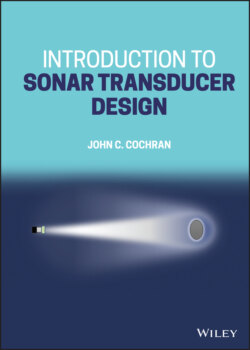Читать книгу Introduction to Sonar Transducer Design - John C. Cochran - Страница 10
Preface
ОглавлениеThis text is the result of my efforts over the years to understand the broad subject of underwater electroacoustic transducer design. To fully understand underwater transducers, one must understand many different aspects of physics, electrical, and mechanical engineering. It is the broad nature of acoustic transduction that I enjoy very much.
I started working in the underwater transducer business in 1983. I joined a small company which specialized in the design and manufacture of underwater acoustic transducers. At the time, I had no idea what a transducer was. I quickly found that you had to be a jack‐of‐all‐trades in order to be successful at making transducers. The wide range of expertise required to fully understand underwater transducer design was very attractive to me. I was not one to be pigeonholed into any one particular area of engineering discipline. I embraced the opportunity to be what I consider a true engineer to be – an individual who employs the basic principles of physics and chemistry to solve practical problems and who can implement these solutions into a manufacturable product.
Unfortunately, the process of “coming up to speed” in transducer design is made very difficult by the lack of specific texts that address the subject. There are texts that address the mechanics of piezo‐electric materials and texts on acoustic theory, but there are very few texts that address the broad range of topics associated with underwater transducer design. As a result, I was constantly bombarded with “rules of thumb” that had their basis in sound physical principles but for which no one could account. Not being one to accept the “rules of thumb” on faith alone, I have endeavored to understand the basis for the theories that are applicable to underwater transducer design. It is these basic principles that I hope to document in this text.
I consider the text to be an introductory text in underwater acoustic transducer design. The text walks through the development of various theories starting from the first principles. In some cases, the mathematical development may lead someone to think that I should have jumped to the answer sooner. However, it is for the beginner in this field that I have written this book. The beginner should feel that he can follow mathematical development completely. I have put many of the intermediate mathematical steps into this text.
Though written for the beginner in this field, the text is also for the advanced student or practicing engineer. The mathematical development is fairly thorough and requires some experience with advanced mathematical functions (such as Bessel’s functions) in order to get the most out of it.
The text is divided into five chapters. The first chapter explores the physics of the acoustic medium outside of the transducer. Since the purpose of a transducer is to generate sound in the water, we must understand the parameters that impact the design of the transducer and its ability to produce acoustic power.
Chapter two begins the development of transducer theory by developing equivalent circuits for simple mechanical and acoustical systems. These principles can sometimes be applied to transducer design but more generally lead to a physical understanding of how a mechanical/acoustical transducer works.
Chapter three addresses acoustic waves in solids. In this chapter, we specifically develop the theory for sound propagation in solids that will ultimately impact the design of the transducer. A transducer is a solid device through which acoustic energy flows. We must understand the propagation of acoustic energy in solids in order to design transducers. The chapter starts off with acoustic waves in non‐piezo‐electric solids and then moves into a thorough discussion of waves in piezo‐electric solids. Piezo‐electricity is reviewed to the point that it is applicable to transducer design.
Chapter four discusses projectors. This chapter brings together elements from the first three chapters. Tools and limitations to projector design are reviewed.
Chapter five discusses hydrophones. Sensor self‐noise and its impact on system design are thoroughly discussed in this chapter.
Enjoy.
John C. Cochran, PhD
